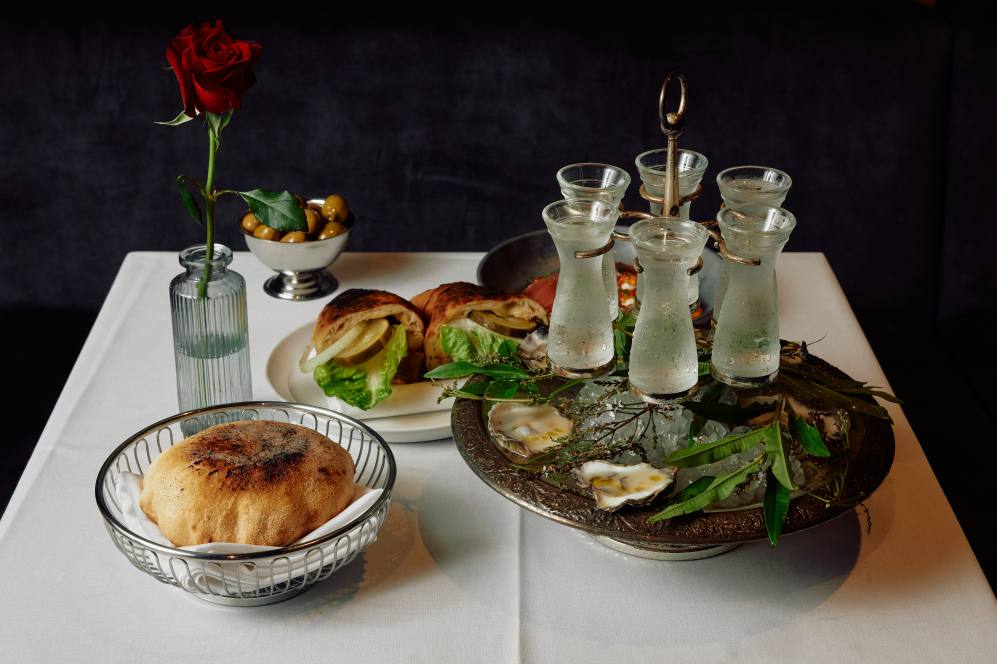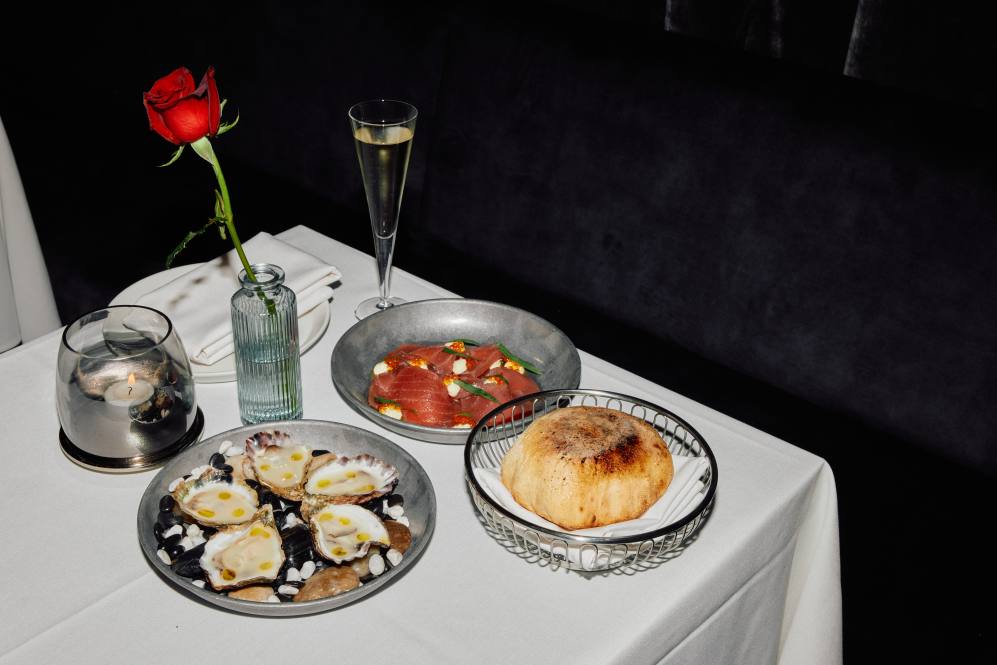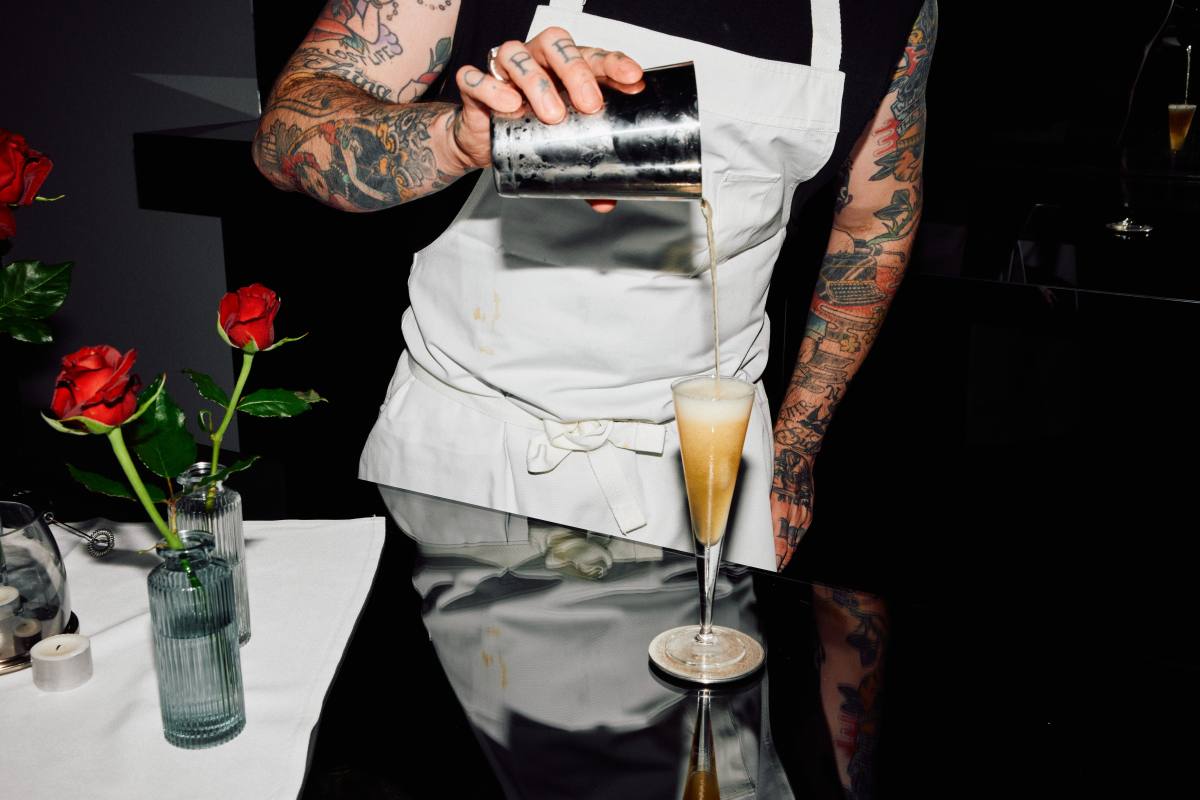Purple Pit is many things — a hotel bar meets an underground club; a place where drinks don’t necessitate instruction manuals; and a venue that is as at home in Melbourne’s CBD as it could be elsewhere. It’s also the first permanent collaboration from long-time friends Joe Jones and Icebergs’ Maurice Terzini, who share a belief that “art, fashion, music, and drinks are all the same ideas … just painted with a different brush”.
When Joe Jones closed the doors to Romeo Lane in 2022 after 10 years, opening another venue was always on the cards. The idea was for Purple Pit to cross over with Romeo’s last stretch, however heritage spaces almost always equal delays. But all good things take time, which was needed to fine-tune the Collins Street bar Jones had been envisioning for years.
“I had a very clear idea of what I wanted it to be like,” he says. “Maurice and I have known each other for eight or nine years now, and we have a mutual love of high-end hotel stuff and divey bars/clubs, too. The idea behind it all is that it’s not a fussy bar in the sense that everything is easy to enjoy.”
The name was decided upon before the site was secured, with the latter part inspired by a bar Terzini once worked at in St Kilda called the Snakepit. “The underground pit element so to speak came from that,” says Jones. While ‘purple’ is an homage to Henry Maas, a well-known figure in Melbourne’s cultural scene who ran the Black Cat Cafe. Purple Pit also happens to be the name of the bar in the original 1933 Nutty Professor movie, which “is such a satirical silly look at high society but still very cool”.

Purple Pit has a similar aesthetic to Romeo Lane, where candles abound and natural light is simply not required. “It’s not really my thing,” says Jones. “I prefer low lighting where everything is warm and glowing. Being underground is something I’m accustomed to. I am trying to sell escapism, basically.”
Jones worked with Latitude to create the space, which went through various iterations
before the final version was decided upon. Purple Pit could have gone one of two ways
thanks to a design brief that covered elements from luxury hotels and grungy bars. “It doesn’t intrinsically feel Australian, which suits me very well,” says Jones. “It feels very international. The walls are curtains and there are upholstered banquettes everywhere. You feel like you are sitting in an expensive handbag. It is almost removed from what’s around you, which is a quality bars can have.”
Purple Pit has opened with a menu that lists around eight cocktails and two to three club serves. Jones’ signature approach remains when it comes to drinks, abiding by the mantra that “drinks don’t need constant reinvention”. He’s spent his bar career focusing on classics, which means there are various iterations of martinis, Negronis, and bellinis that have been moderately riffed.
“Alcohol is the glue of society, and it has already been well practiced,” he says. “There are only two or three things in every drink and if there is another ingredient dropped in, it’s usually tiny. It’s Euro-centric and classic. You don’t need to overthink it and that’s the bullseye of everything we are doing.”
Take the bellini, which has been transformed from a “turbo, viscous, gluggy thing” to a drink based on burnt honey vodka and redistilled peach purée topped with fizz. The Disco Martini is a Romeo Lane throwback and is a “martini for people who aren’t massively into them”. Two shots of ice-cold gin gets mellowed out with Farlernum and
bitters “to soften the blow”.
There’s also the Emerald City, a highball made with a jasmine spirit, Champagne reduction, and green apple soda and the Peach Negroni, with all the drinks on the
launch menu developed collectively by staff. “I usually work solo, and this is the first time I’ve let people in on the development phase,” says Jones. “A lot of them are
interested in furthering their skillsets and broadly it will be a heavily rotating drinks list. There will be staples that remain but there will be drinks that change weekly or
monthly. I would like to be nimble with ideas.”
Purple Pit is serving club favourites including a Dark and Stormy with chamomile ginger beer from the tap, a Cosmo highball, a Bloody Mary, and a Painkiller made with fior di latte from Piccolina. “We’re also doing what we call a Ticket to Ride which is our version of a party starter,” says Jones. “It’s a half martini with a 90ml Champagne pour served with a spoon of crème fraîche whipped with yuzu kosho and smoked salmon roe which is a savoury ‘one, two, three’ mouthful. It’s halfway between a thinking drink and things to get your tastebuds going.”

Speaking of food, Purple Pit’s food offering has been curated by Jones, who trained as a chef before venturing into bar territory. It’s here where the Icebergs DNA is found in the form of tuna cured in brown rice vinegar, oysters and caviar, and a late-night calzone designed to share.
“It’s all the things Maurice and I like to eat both being Italian Australian,” says Jones. “There’s a lot of stuff that goes down well with a martini or a glass of Champagne …
some of it is super rich and other dishes are refreshing and palate awakening.”
Besides its luxe interior, concise drinks program, and Icebergs in Melbourne plates, Purple Pit’s operating hours offer another point of difference, with the bar opening at
3pm each day. “There is nowhere nice around here that opens before 5pm, so we wanted to cater to workers in the area and people in the building,” says Jones.
After an eleven-month delay, Purple Pit is now in full swing, cutting the ribbon at the end of 2023 to offer a familiar yet new experience to Melburnians. “I think people
sometimes forget bars are meant to be good additions to their communities,” says Jones. “I would rather be everything to someone than something to everyone.”

